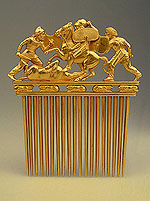October 18, 2001 - January 20, 2002
 The exhibition includes 224 items, 13 of which are on display for the first time. They are remarkable finds made by Ufa-based archaeologists under the direction of Anatoly Pshenichniuk during excavations of the Filippovka burial mounds in the Orenburg region of the southern Urals in the late 1980s that caused a sensation in the scholarly world.
These unique architectural finds are exceptionally beautiful and expressive works of art, the greater part of which are made of gold or decorated with gold elements. Two secret hiding-places in a grave that was plundered back in ancient times preserved untouched some remarkable gold artistic works in the Scythian-Siberian Animal style. The most unusual finds were massive wooden figures of deer with mighty branched antlers covered with gold plates. The image of the deer that also appears on other artefacts from Filippovka has become the central theme that provides the exhibition with its title.
Of great interest are the iron swords with zoomorphic images and gold finishing. No less fascinating is a set of formal tableware made of gold and silver that is believed to have come from Iran.
Despite the fact that the burial mounds were plundered back in ancient times, many items were left untouched, particularly those concealed in secret hiding-places: unique sculptures of deer executed in wood and faced with gold and silver plates, dress weaponry and elements of harness, numerous gold plates decorated in the Scythian animal style that adorned from wooden bowls, Achaemenid gold and silver vessels, and bronze cauldrons. In its entirety this striking and exceptional collection was previously practically unknown even to specialists, and so one of the chief tasks of the exhibition was to present this unique material to the general public.
The exhibition was preceded by a three-year period of preparation during which many of the items were restored by the Hermitage's specialists.
In the exhibition the Hermitage has presented a whole group of formal vessels decorated with images of real and fantastic beasts, scenes of attacks by predators, religious and hunting subjects. In total the museum's Scythian and Sarmatian collections account for 85 items, predominantly from the area north of the Black Sea, the northern Caucasus, Siberia and the Altai mountains. They are masterpieces of ancient art from the world-renowned "royal" Scythian burial sites -- the kurgans of Solokha, Chertomylik and Kul'-Oba, the Pazyryk burial mounds and also from the Siberian collection of Peter the Great.
The inclusion of these artefacts in the exhibition reflects the basic idea of the exhibition — to demonstrate the unity that characterizes the culture of the nomads of the steppe belt of Eurasia over a period of a thousand years and to show the unique distinct qualities of individual ethnic components. Besides, the exhibition is intended to bring out the degree of interaction and mutual influence between different cultures, their openness, the variety of contacts (military, economic and diplomatic) between nomadic and urban civilizations, between the Scythian, Greek and Iranian worlds. The most vivid element reflecting the chief concept of the exhibition was to be the deer that is one of the main folklore and religious motifs in the ideology and artistic culture of the early nomads of Eurasia.
A scholarly conference is taking place in parallel with the exhibition.
Event source: hermitage.ru
 Print this news Print this news
Events archive for 18 October' 2001.
Events archive for October' 2001.
Events archive for 2001 year.
|